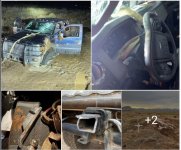Just wanted to put this out there. I read where someone was killed during a recovery in the Kingman AZ area. The vehicle was a big Ford Super Duty. The recovery vehicle was using the trailer hitch to attach a 3" strap. Unfortunately, the hitch insert failed and the separated part of the hitch went thru the windshield of the stuck vehicle, killing the driver.
https://www.jlwranglerforums.com/fo...s-after-getting-stuck-in-the-mud.98609/page-2
There's somethings we can learn from this. That hitch was a long drop hitch insert. Attaching the strap to the ball would put the insert bar in bending load, which you can equate to using a cheater bar to pry on one side of something. This would drastically increase the local loads on one side of the insert. The longer the drop on the hitch, the more mechanical leverage on the insert bar. Don't do this with a drop hitch.
If attaching to a hitch, use a straight insert and preferably a solid steel insert.
Nylon straps and especially those new "kinetic ropes" store a lot of energy and will act like a huge slingshot. That's the beauty of them and the hazard.
I know it's a hassle, but a simple safety line can be used to choke the snatch strap/kinetic rope a short distance from the attach point, then anchored to a different point on the recovery vehicle. The slack in the safety rope should be enough to allow full movement during the "snatch" ,but short enough to arrest any failed attach structure on the recovery vehicle before it can travel half the distance to the other vehicle. The same can be used on the stuck vehicle. The rope can be inexpensive poly rope. It won't see much load from a failed strap.
View attachment 378894


